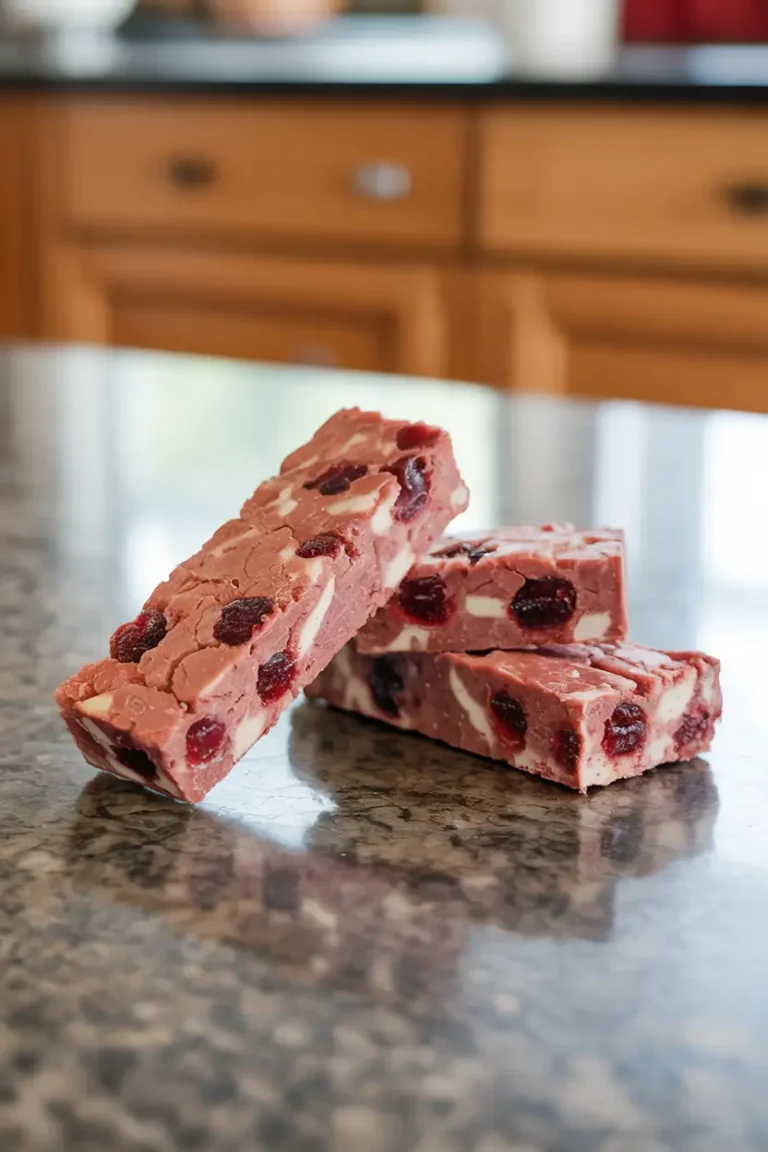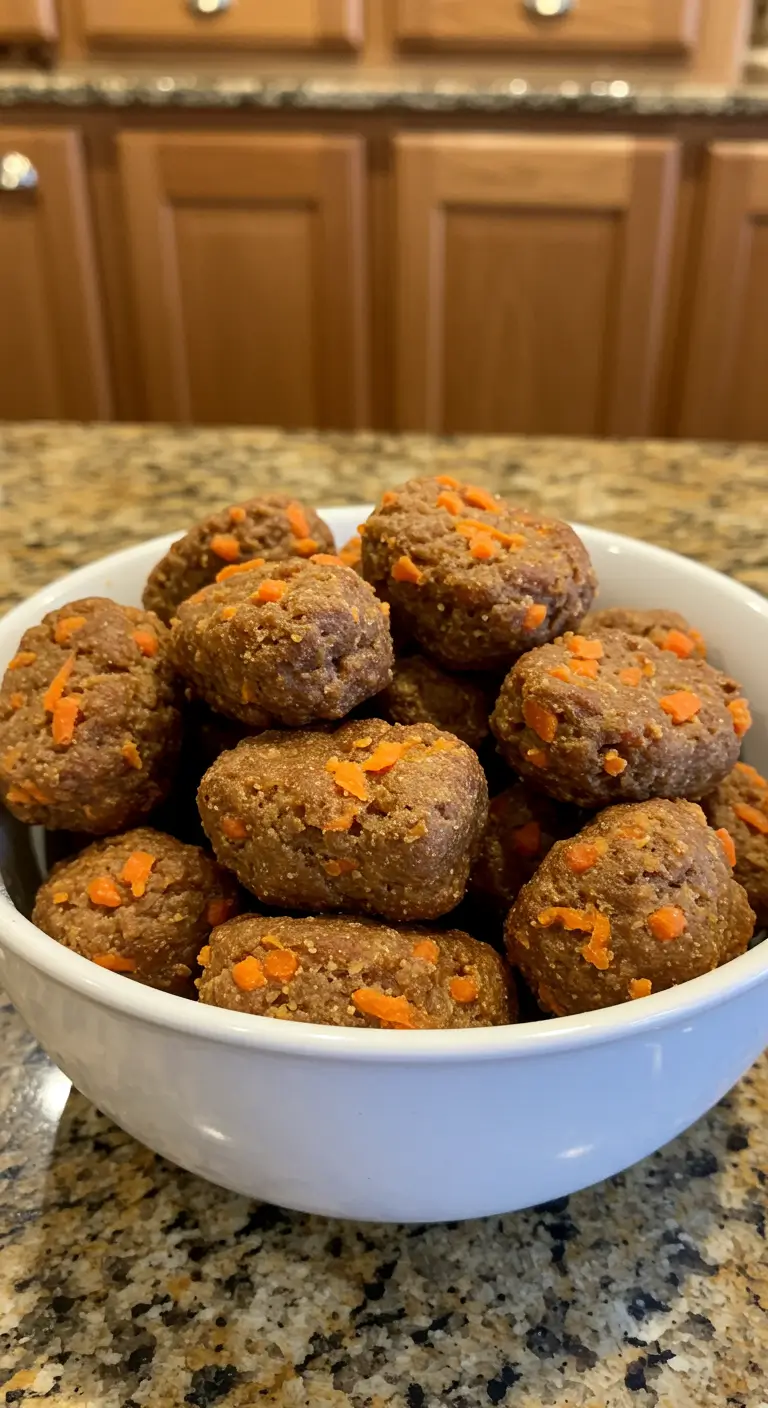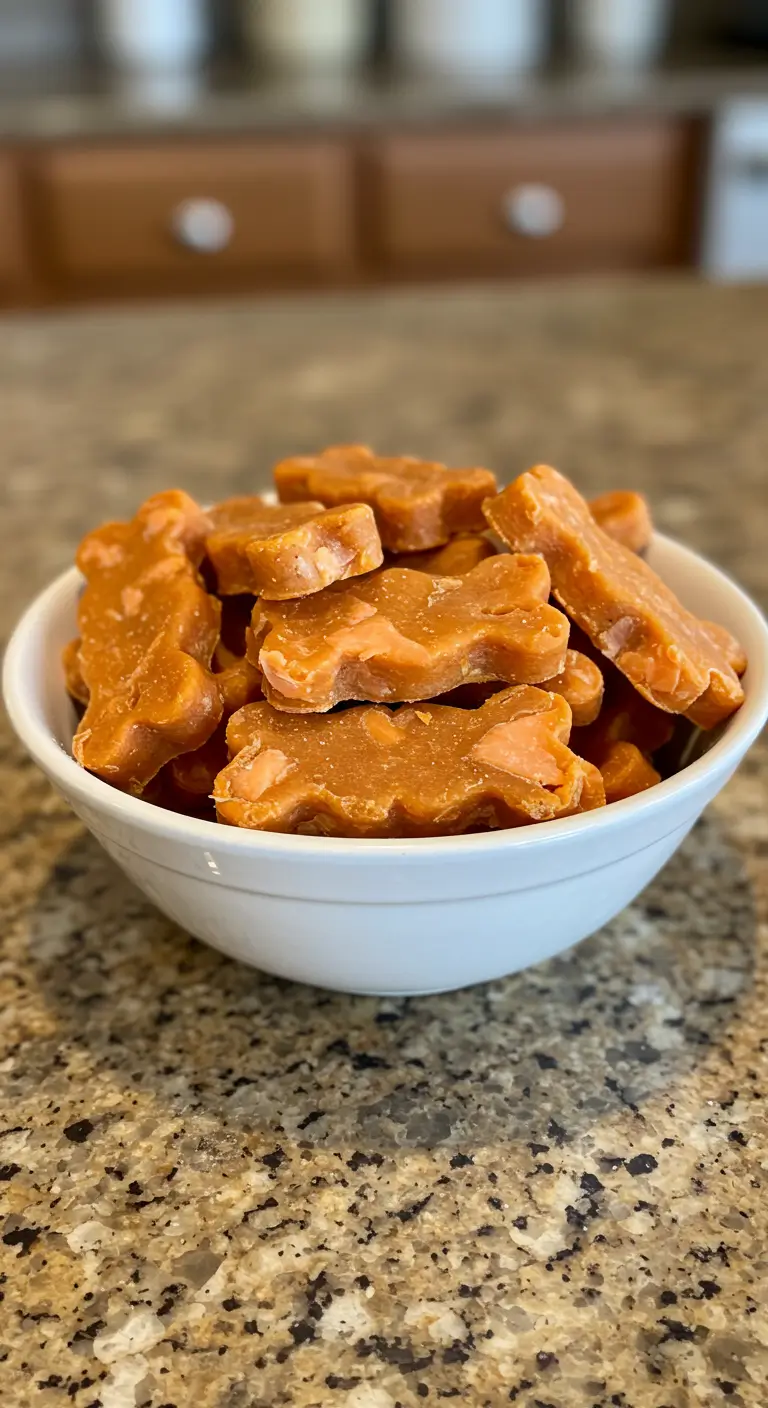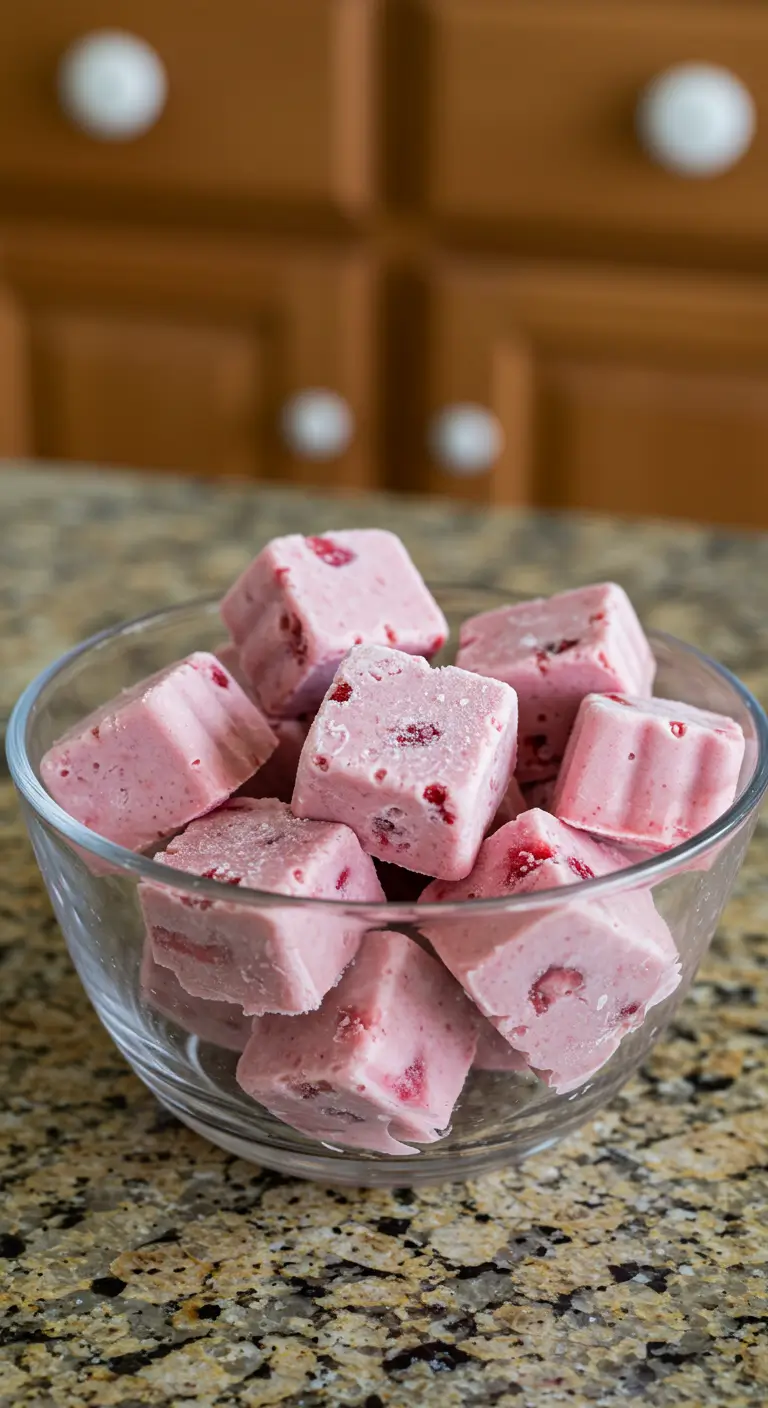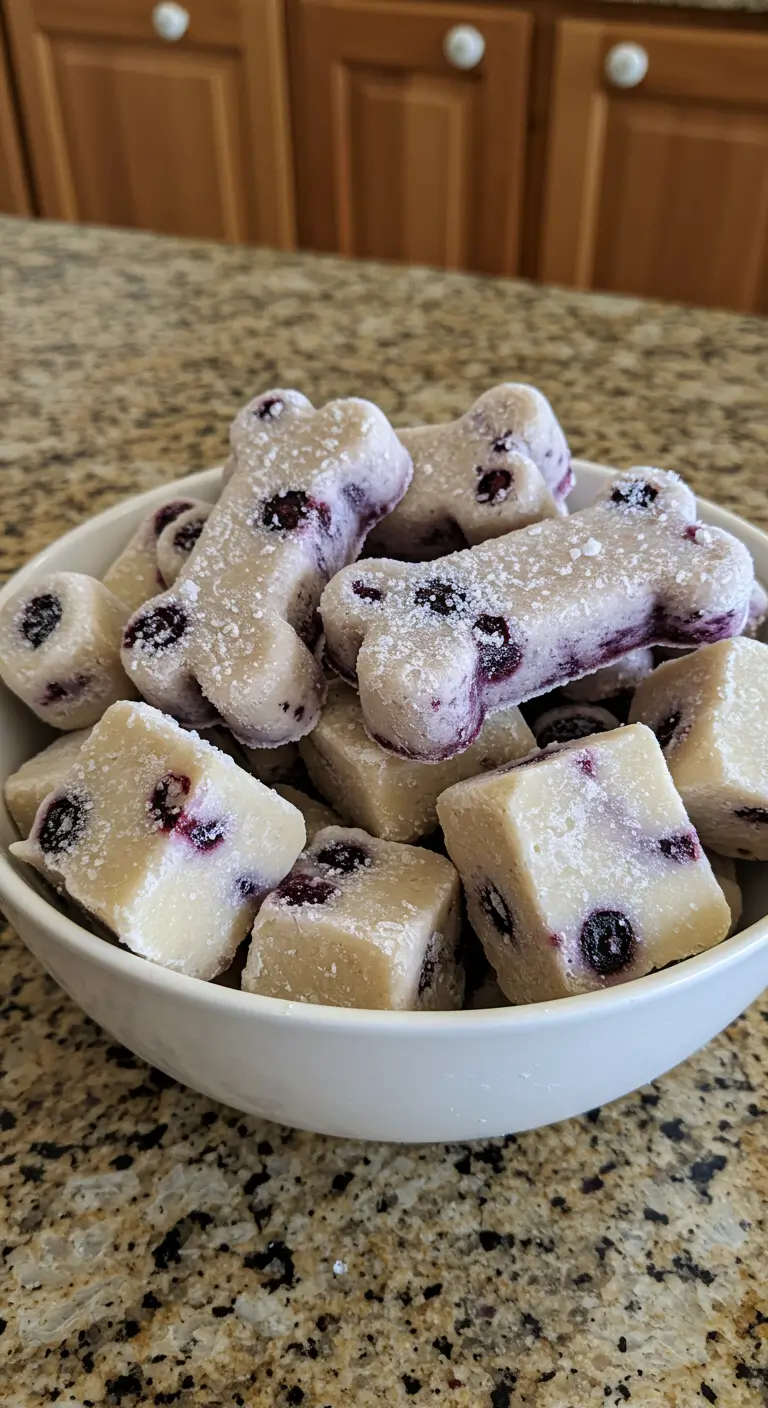10 Easy Crunchy Homemade Dog Treats for Adult Dogs
So here’s the thing, I used to spend way too much money on store-bought dog treats that Benji would barely touch. Half the time, he’d give them that “are you kidding me?” look and walk away. That’s when I started making my own crunchy homemade dog treats, and let me tell you, everything changed!
Making homemade dog treats isn’t just about saving money (though your wallet will thank you). These crunchy dog treat recipe options give you complete control over ingredients, promote dental health, and create treats that get your pup excited. Plus, there’s something incredibly satisfying about watching your dog crunch through something you made yourself.
Today, I’m sharing 10 amazing healthy homemade dog treats that’ll transform your kitchen into the neighborhood’s most popular doggy bakery. These aren’t complicated recipes, just simple, wholesome, crunchy homemade dog treats that pack serious nutritional value and serious crunch factor.
Table of Contents
Why Crunchy Homemade Dog Treats Excel for Adult Dogs

The advantages of homemade dog treats that are crunchy extend far beyond their flavor. Understanding why these treats work so well helps you make better choices for your pup’s health and happiness.
The Science Behind Crunchy Texture for Dental Health
Every time your dog chomps down on crunchy dog treats, they’re essentially giving their teeth a cleaning session. The firm texture mechanically removes plaque and tartar buildup that leads to serious dental problems down the road.
Research shows that dogs who regularly consume appropriately textured treats have significantly better oral health than those eating only soft foods. The abrasive action of crunchy dog treats recipe options helps maintain healthier gums and fresher breath naturally.
I learned this firsthand when our vet pointed out early tartar buildup on Benji’s teeth. After switching to exclusively healthy homemade dog treats with a proper crunch factor, his next dental exam showed remarkable improvement.
Nutritional Advantages of Homemade vs Commercial
Crunchy homemade dog treats allow complete ingredient control, eliminating questionable preservatives, artificial colors, and mystery meat sources common in commercial options. You choose every single component that goes into your dog’s treats.
This control becomes especially valuable for dogs following specialized diets or those with sensitivities. Unlike mass-produced treats with lengthy ingredient lists, homemade versions keep things simple and transparent.
Storage and Convenience Benefits
Properly made homemade crunchy dog treats store incredibly well, lasting 2-3 weeks in airtight containers. This makes batch-baking practical and economical for busy pet parents.
The sturdy texture of the crunchy dog treats recipe results means they travel well, work perfectly for training sessions, and maintain their appeal even after extended storage periods.
Essential Ingredients for Perfect Crunchy Dog Treats
Creating consistently excellent crunchy dog treats requires understanding which ingredients deliver optimal texture, nutrition, and safety for adult dogs.
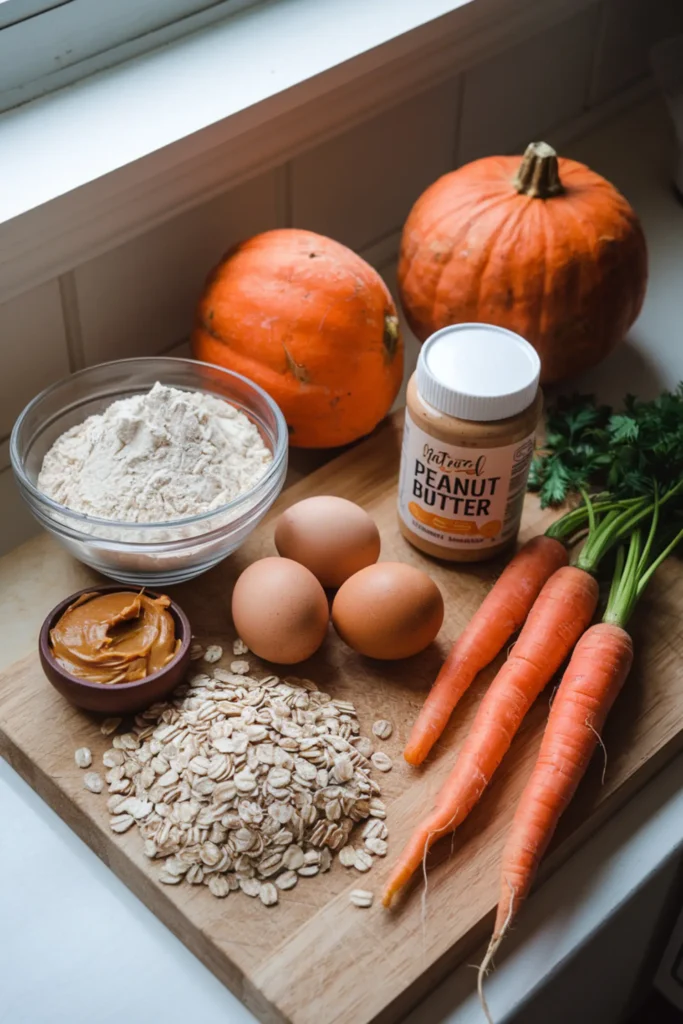
Base Flour and Binding Options
| Flour Type | Best For | Texture Result | Special Notes |
|---|---|---|---|
| Whole wheat flour | Most dogs | Classic crunch | High fiber, widely available |
| Oat flour | Sensitive stomachs | Mild crunch | Naturally gluten-free |
| Rice flour | Grain sensitivities | Extra crispy | Very light texture |
| Coconut flour | Grain-free diets | Dense crunch | Use sparingly, very absorbent |
The foundation of any great, healthy homemade dog treats starts with choosing appropriate base ingredients. Whole wheat flour remains my go-to choice for most crunchy dog treat recipe options because it provides excellent structure while delivering nutritional benefits.
For dogs with grain sensitivities or those following our allergy-friendly approaches, alternative flours work wonderfully. Rice flour creates especially crispy results that many dogs seem to prefer over traditional wheat-based treats.
Protein and Flavor Enhancers
Natural peanut butter (xylitol-free only) serves dual purposes in homemade dog treats – providing irresistible flavor while acting as a binding agent. Always verify that peanut butter contains no artificial sweeteners, which can be dangerous for dogs.
Lean proteins like cooked chicken, beef, or fish add substantial nutritional value while creating treats dogs find absolutely irresistible. Canned salmon or tuna work particularly well for crunchy dog treats because they distribute evenly throughout the dough.
Eggs function as natural binders while adding high-quality protein and helping achieve that perfect golden-brown color during baking.
Vegetables and Nutritional Boosters
Fresh vegetables like carrots, sweet potatoes, and apples contribute vitamins, minerals, and natural sweetness to healthy dog treats. Grating vegetables finely ensures even distribution and prevents texture issues.
Rolled oats add interesting texture variety while providing beneficial fiber. Ground flaxseed contributes omega-3 fatty acids that support coat health and reduce inflammation.
10 Irresistible Crunchy Treat Varieties for Adult Dogs
Now for the exciting part – let me walk you through 10 amazing crunchy homemade dog treat varieties that’ll make your pup the happiest dog on the block!

Classic Peanut Butter Favorites
Peanut Butter & Banana Biscuits represent the ultimate crowd-pleaser in our house. The combination of creamy natural peanut butter with sweet, ripe bananas creates a crunchy dog treats recipe that smells incredible during baking and delivers serious satisfaction.
The natural sugars in bananas help develop beautiful golden-brown coloring while providing potassium and essential vitamins. These homemade crunchy dog treats work exceptionally well for training because most dogs consider the peanut butter-banana combination absolutely irresistible.
Apple & Peanut Butter Chips offer a delightful twist on traditional peanut butter treats. Fresh apples add natural sweetness and interesting texture variety, while peanut butter provides protein and the flavor dogs crave most.
These healthy dog treats emerge from the oven perfectly crispy and store beautifully for weeks when kept in airtight containers. The apple pieces create pleasant texture surprises that keep dogs interested, bite after bite.
Vegetable-Packed Nutritional Options
Pumpkin & Oatmeal Bites have become my autumn favorites, though honestly, I make them throughout the year now. Pumpkin provides excellent digestive fiber while creating naturally sweet, crunchy dog treats that most dogs find appealing.
The combination works particularly well for dogs with sensitive stomachs since pumpkin is exceptionally gentle on digestive systems. Rolled oats add substance and help achieve that perfect crunchy texture that promotes dental health.
Carrot & Parsley Crunchies pack serious nutritional benefits while delivering a satisfying crunch factor. Fresh carrots provide beta-carotene for eye health, while parsley actually helps freshen breath naturally – talk about multi-functional crunchy dog treats recipe benefits!
The key with these homemade crunchy dog treats is grating carrots finely enough that they distribute evenly throughout the dough. This ensures every bite contains beneficial nutrients while maintaining consistent texture.
Cheddar & Apple Dog Biscuits combine savory cheese flavors with sweet apple pieces for healthy dog treats that appeal to dogs who enjoy variety. Real cheddar cheese adds protein and calcium, while apples contribute fiber and natural enzymes.
These treats require slightly extended baking times to achieve proper crunchiness due to the moisture content in both ingredients, but the results definitely justify the extra patience required.
Protein-Rich Gourmet Selections
Beef & Sweet Potato Biscuits satisfy dogs who prefer heartier, more substantial, crunchy dog treats. Using lean ground beef creates protein-packed snacks, while sweet potatoes add vitamins and natural sweetness that most dogs find completely irresistible.
The combination creates treats with incredible aroma during baking – be prepared for your dog to station themselves permanently in the kitchen! These crunchy dog treat recipe options work especially well for larger breeds who need more substantial treats.
Salmon & Flaxseed Crunchers appeal to dogs who enjoy fish flavors while providing omega-3 fatty acids essential for coat and skin health. Canned salmon works perfectly for these homemade crunchy dog treats, and flaxseeds add extra nutrition plus interesting texture variety.
These treats emerge with beautiful pink coloring and smell absolutely amazing while baking. They’re particularly popular with dogs who might be pickier eaters since the distinctive salmon flavor proves quite appealing.
Chicken & Rice Crackers offer familiar flavors in perfectly crunchy form. Using cooked chicken provides lean protein, while rice flour creates especially crispy, healthy homemade dog treats. These work wonderfully for dogs transitioning from commercial treats to homemade versions.
The mild flavors make these suitable for dogs with sensitive palates, and they’re excellent choices for training sessions since most dogs respond enthusiastically to chicken flavors.
Tuna & Cheese Bites combine two ingredients most dogs consider absolute delicacies. Cheese gives these crunchy homemade dog treats calcium and a delicious flavor, while canned tuna supplies protein and omega-3s.
The strong flavors make these perfect for special occasions or when you really want to make an impression. Just be prepared – your dog might develop very high expectations after experiencing these gourmet crunchy dog treats recipe results!
Premium Gourmet Options
Lamb & Rosemary Biscuits represent the sophisticated end of the homemade crunchy dog treats spectrum. Lamb provides novel protein for dogs who might have sensitivities to more common proteins, while fresh rosemary adds aromatic appeal and natural preservation qualities.
These healthy dog treats have an almost bakery-like quality and work wonderfully for special occasions or when you want to spoil your pup with something extra special.
Complete Baking Guide for Perfect Crunchy Results

Creating consistently excellent crunchy dog treats requires understanding proper techniques that ensure safe, delicious results every single time.
Essential Equipment and Setup
| Equipment | Purpose | Why Important |
|---|---|---|
| Large mixing bowls | Dough preparation | Prevents ingredient spillage |
| Rolling pin | Even thickness | Ensures uniform baking |
| Cookie cutters | Shape consistency | Professional appearance |
| Wire cooling racks | Proper cooling | Prevents soggy bottoms |
| Airtight containers | Storage | Maintains crunchiness |
Proper equipment setup makes the difference between frustrating baking sessions and enjoyable dog treats recipe experiences. Sharp cookie cutters create clean edges that bake evenly, while wire cooling racks prevent trapped moisture from softening your perfectly crunchy results.
Dough Preparation Techniques
Perfect homemade dog treats start with properly prepared dough that holds together well while maintaining the right consistency for rolling and cutting.
The ideal dough should feel firm but not dry, pliable but not sticky. Too much liquid creates treats that never achieve proper crunchiness, while insufficient moisture makes them tough and potentially unsafe for chewing.
Add liquids gradually while mixing thoroughly between additions. Environmental factors like humidity significantly affect how much liquid you’ll need, so paying attention to dough texture matters more than following exact measurements blindly.
Temperature and Timing Guidelines
Most successful crunchy homemade dog treats bake at moderate temperatures (325-350°F) for 25-35 minutes, depending on thickness and specific ingredients used.
Lower temperatures over longer periods create the best crunchy results without risking burnt exteriors or raw centers. The treats should sound hollow when tapped gently and feel firm to the touch when properly finished.
Underbaking leaves treats chewy rather than crunchy, while overbaking can make them dangerously hard for safe consumption. Finding that perfect balance takes practice but becomes intuitive with experience.
Cooling and Storage Best Practices
Proper cooling is absolutely crucial for achieving maximum crunchiness in homemade dog treats. Always allow treats to cool completely on wire racks before storing, which prevents trapped moisture from softening the texture you worked so hard to achieve.
Airtight containers maintain freshness for 2-3 weeks at room temperature. For longer storage, freezing works wonderfully – just thaw individual portions as needed without compromising texture or flavor.
Nutritional Benefits of Each Treat Variety
Understanding the specific nutritional advantages of different crunchy dog treat recipe options helps you choose the best varieties for your dog’s individual needs and preferences.
Protein Content Analysis
| Treat Variety | Protein Level | Best For | Special Benefits |
|---|---|---|---|
| Beef & Sweet Potato | High (18-22%) | Active dogs | Muscle maintenance |
| Chicken & Rice | Moderate (14-18%) | All dogs | Easy digestion |
| Salmon & Flaxseed | High (16-20%) | Skin/coat health | Omega-3 fatty acids |
| Peanut Butter & Banana | Moderate (12-16%) | Training treats | High palatability |
Different crunchy homemade dog treat varieties serve different nutritional purposes, allowing you to customize your dog’s treat selection based on their specific health needs and activity levels.
High-protein options like Beef & Sweet Potato Biscuits work exceptionally well for active dogs who need additional protein for muscle maintenance and energy. Meanwhile, gentler options like Chicken & Rice Crackers suit dogs with sensitive digestive systems.
Vitamin and Mineral Contributions
Carrot & Parsley Crunchies provide exceptional beta-carotene levels for eye health, while Pumpkin & Oatmeal Bites deliver significant fiber for digestive wellness. Apple & Peanut Butter Chips contribute vitamin C and natural enzymes that support overall health.
These nutritional benefits make homemade dog treats significantly more valuable than empty-calorie commercial alternatives that provide little beyond basic satisfaction.
Safety Guidelines for Homemade Dog Treats
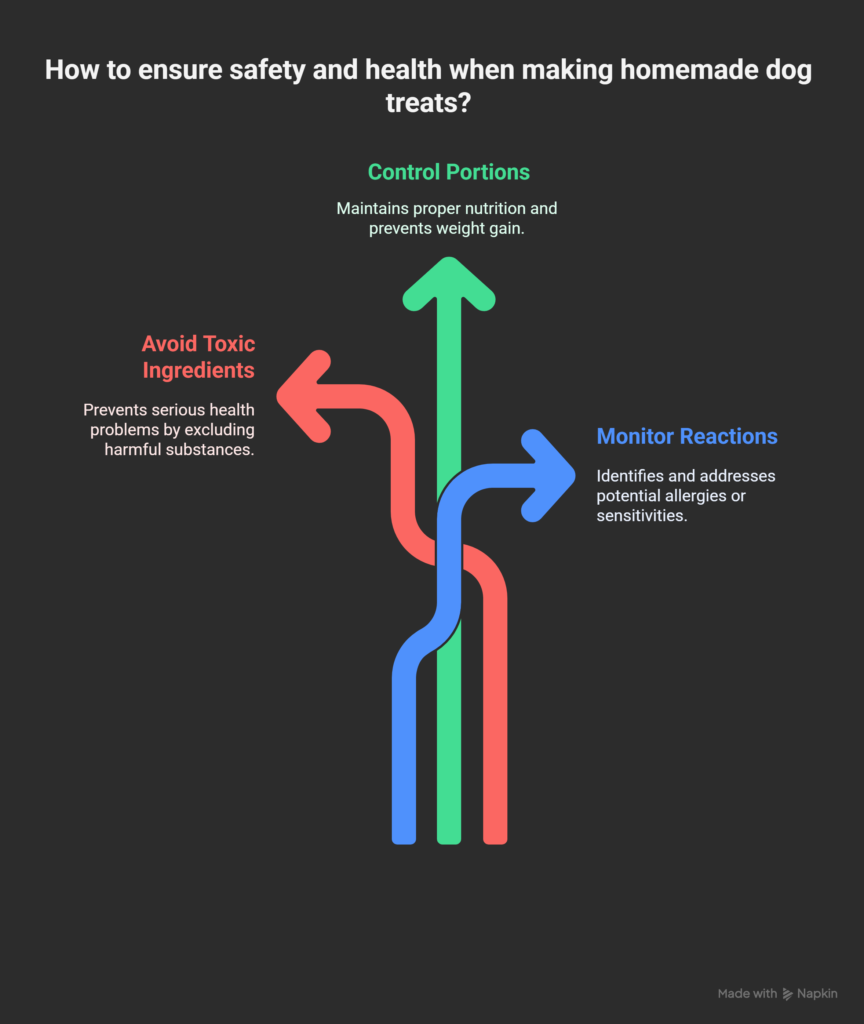
Creating safe, homemade dog treats requires understanding potential hazards and implementing proper safety protocols throughout the baking process.
Ingredients to Absolutely Avoid
- Avoid using chocolate, xylitol, raisins, grapes, onions, or garlic in any recipe for crunchy dog treats.
- Make sure peanut butter is free of artificial sweeteners and xylitol at all times.
- Avoid excessive salt, sugar, or spices that could upset sensitive digestive systems
- Skip ingredients you’re unsure about – when in doubt, leave them out entirely
These toxic ingredients can cause serious health problems even in small amounts, so maintaining vigilance about ingredient safety is absolutely critical for dog treats.
Proper Portion Control Guidelines
Even the healthiest homemade dog treats should represent only about 10% of your dog’s daily caloric intake to maintain proper nutrition balance and healthy weight.
For average-sized adult dogs, 2-4 small treats daily work well for most crunchy dog treat recipe varieties. Larger dogs can handle slightly more, while smaller breeds need proportionally reduced amounts.
Monitor your dog’s weight and body condition regularly, adjusting treat portions as needed to prevent unwanted weight gain that could compromise their health.
Monitoring for Adverse Reactions
Introduce new crunchy homemade dog treat varieties gradually, especially if your dog has known food sensitivities or allergies. Watch carefully for any digestive upset, skin changes, or behavioral differences after trying new recipes.
Most dogs tolerate homemade treats much better than commercial versions since you control every ingredient, but individual sensitivities can still occur with any new food introduction.
Storage and Serving Guidelines for Maximum Freshness

Proper storage techniques ensure your dog treats maintain their texture, flavor, and nutritional value for maximum safety and enjoyment.
Container Selection and Organization
- Glass containers with tight-fitting lids work excellently for maintaining crunchiness
- Plastic storage containers with secure seals are practical for larger batches
- Avoid containers that previously held strong-smelling human foods
- Label containers with baking dates to track freshness
Mason jars work wonderfully for smaller quantities and allow easy visual monitoring of remaining treats. For larger batches, food-grade plastic containers with tight-fitting lids provide practical and economical storage solutions.
Freshness Indicators and Safety Checks
Properly stored healthy homemade dog treats should maintain their crunchy texture and pleasant aroma throughout their storage life. Any signs of moisture, mold, unusual odors, or texture changes indicate it’s time to discard them and prepare fresh batches.
Most crunchy dog treat recipe varieties stay fresh for 2-3 weeks when stored correctly, though treats containing fresh meat or dairy products may have shorter safe storage periods.
Creative Serving and Training Applications
Beyond basic treat-giving, these sturdy, crunchy dog treats work wonderfully for training sessions, puzzle toys, or special celebration occasions. Their firm texture makes them perfect for Kong toys or treat-dispensing puzzles that provide mental stimulation.
For special celebrations, you can create simple “cakes” by layering different treat varieties or using themed cookie cutters for holidays and special occasions.
Troubleshooting Common Baking Problems
Even experienced bakers occasionally encounter challenges when making homemade dog treats. Here are proven solutions for the most frequently encountered issues.
Addressing Texture Problems
Treats Turn Out Too Soft:
- Usually indicates insufficient baking time or excessive liquid in the dough
- Put the soft treats back in the oven for a further five to ten minutes, monitoring often.
- For future batches, reduce the liquid slightly or extend the baking time until the treats sound hollow when tapped
Treats Become Too Hard:
- Typically results from overbaking or insufficient liquid in the original dough
- While still safe, overly hard treats might be uncomfortable for some dogs to chew
- Soften slightly hard treats by storing them with a slice of fresh apple overnight
Uneven Browning Issues:
- Usually caused by inconsistent dough thickness or oven hot spots
- Roll the dough to uniform thickness using guides if necessary
- Halfway through the cooking process, rotate the baking sheets for more uniform results.
Ingredient Substitution Guidelines
When specific ingredients aren’t available, successful substitutions can maintain the quality of your crunchy dog treats recipe results:
- Replace whole wheat flour with oat flour for grain-sensitive dogs
- Substitute coconut oil for other oils if dogs have fat sensitivities
- Use canned pumpkin instead of fresh when convenience matters
- Replace eggs with ground flaxseed mixed with water for binding
Building Sustainable Treat-Making Routines
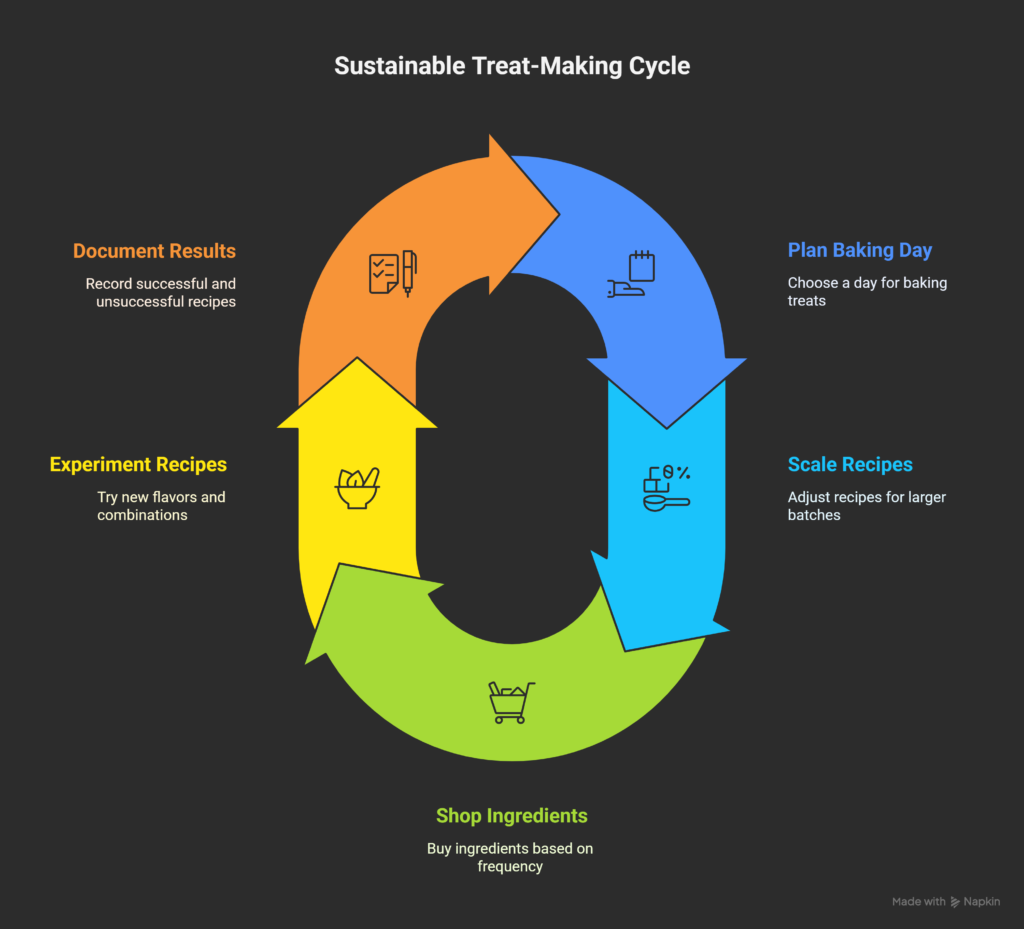
Creating consistent, crunchy dog treats production routines ensures you always have fresh, healthy options available while maximizing efficiency and minimizing stress.
Weekly Batch-Baking Strategies
Choose one designated day weekly for preparing multiple healthy homemade dog treats. This approach maximizes kitchen efficiency while ensuring a constant supply of fresh treats for your pup.
Most recipes scale up easily if you want larger quantities, and having different varieties available simultaneously gives your dog exciting options while making efficient use of your valuable time.
Ingredient Shopping and Storage Tips
Buy baking ingredients in quantities that match your production frequency. Shelf-stable items like whole wheat flour, oats, and canned pumpkin keep well for months, while fresh ingredients like apples or bananas should be purchased closer to planned baking sessions.
Consider seasonal ingredients like fresh herbs from your garden or seasonal vegetables for added variety and potential cost savings on your homemade dog treats ingredient expenses.
Recipe Experimentation and Documentation
Once you understand the fundamentals of making crunchy dog treats, it’s fun and satisfying to try out new flavor combinations. Start with proven ingredient combinations before attempting more adventurous mixtures.
Keep detailed notes about successful variations so you can easily recreate favorites and avoid repeating less successful experiments that might waste time and ingredients.
Key Takeaways for Crunchy Homemade Dog Treats Success
- Crunchy homemade dog treats provide superior dental health benefits compared to soft commercial alternatives
- You have complete control over the ingredients in these homemade crispy dog treats, eliminating questionable preservatives and artificial additives.
- Healthy homemade dog treats typically cost significantly less than premium commercial options while delivering better nutrition
- Proper storage techniques keep crunchy dog treats recipe results fresh for 2-3 weeks in airtight containers
- Crunchy homemade dog treats work excellently for training, puzzle toys, and special occasion celebrations
- Always introduce new treat varieties gradually, and keep an eye out for any negative reactions in dogs that are sensitive.
- Batch-baking strategies maximize efficiency while ensuring a constant supply of fresh, appealing treats
- Different treat varieties serve different nutritional purposes, allowing customization based on individual dog needs
Conclusion: Creating Dental Health and Happiness Through Homemade Treats
Making crunchy homemade dog treats has transformed not just Benji’s dental health, but our entire relationship with treat time. There’s something incredibly special about creating wholesome, delicious treats that promote oral health while bringing genuine joy to your dog’s daily routine.
These 10 varieties provide enough options to keep any adult dog excited about treat time while delivering real nutritional and dental benefits. Whether your pup prefers classic peanut butter combinations, vegetable-packed options, or protein-rich gourmet selections, you’ll find crunchy dog treat recipe combinations that work perfectly for their individual tastes and dietary requirements.
The journey from store-bought disappointments to healthy homemade dog treats success doesn’t happen overnight, but every single effort contributes to your dog’s long-term health and happiness. Start with simpler recipes, build your confidence gradually, and don’t worry about achieving perfection immediately.
Your dog will appreciate every single attempt, regardless of how Pinterest-worthy the final results might appear. The love and care you put into making crunchy homemade dog treats show in ways that go far beyond appearance – it shows in improved dental health, better nutrition, and the special bond that develops when you create something wonderful with your own hands.
FAQs About Crunchy Homemade Dog Treats
How long do homemade crunchy dog treats stay fresh?
Properly baked and stored crunchy homemade dog treats maintain freshness for 2-3 weeks in airtight containers at room temperature. Treats containing meat or dairy may have shorter shelf lives of 1-2 weeks. Always check for signs of mold, unusual odors, or texture changes before serving, and when in doubt, make fresh batches.
Can I substitute ingredients if my dog has allergies?
Absolutely! Healthy homemade dog treats are perfect for dogs with allergies because you control every ingredient. Replace whole wheat flour with oat or rice flour for grain sensitivities, use coconut oil instead of other fats, and substitute proteins based on your dog’s specific needs. Always introduce new ingredients gradually.
What’s the best way to achieve maximum crunchiness?
Perfect crunchy dog treats recipe results come from proper dough consistency, appropriate baking temperatures (325-350°F), and adequate baking time (25-35 minutes). The treats should sound hollow when tapped and feel firm. Proper cooling on wire racks and airtight storage maintain that satisfying crunch factor.
How many treats can I safely give my dog daily?
Crunchy homemade dog treats should comprise no more than 10% of your dog’s daily calories. For average-sized adult dogs, 2-4 small treats daily work well. Larger breeds can handle slightly more, while smaller dogs need proportionally less. Always adjust regular meal portions if giving multiple treats.
Can I freeze homemade dog treats for longer storage?
Yes! Homemade crunchy dog treats freeze excellently for up to 3 months without losing texture or nutritional value. Freeze treats in portion-sized containers and thaw only what you need. This allows you to batch-bake large quantities while maintaining fresh treats available constantly.
What equipment do I really need to get started?
Basic crunchy dog treats recipe success requires mixing bowls, a rolling pin, cookie cutters, baking sheets, and wire cooling racks. While specialized equipment can be helpful, these essentials will produce excellent results. Invest in quality airtight storage containers to maintain freshness after baking.
References and Resources
This comprehensive guide draws from veterinary nutritionist consultations, canine dental health research, and extensive practical experience creating safe, nutritious homemade dog treats. For additional information about canine nutrition and safe treat preparation, reference these trusted authorities:
American Kennel Club (AKC) – Evidence-based guidance on safe ingredients for homemade dog treats, proper nutrition for adult dogs, and dental health benefits of appropriate textures.
PetMD – Veterinary-reviewed research on canine dental health, the role of texture in oral hygiene, and comprehensive safety guidelines for homemade treat preparation.
Hill’s Pet Nutrition – Scientific studies on canine nutrition requirements, dental health maintenance through diet, and the benefits of controlled ingredient feeding.
Spot Pet Insurance – Professional advice on portion control for treats, integrating homemade options into balanced nutrition plans, and monitoring for food sensitivities.
ESSENTIAL: Always consult your veterinarian before making significant dietary changes, especially if your dog has specific health conditions, allergies, or special nutritional requirements.


